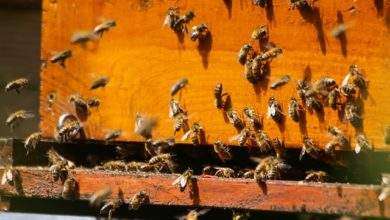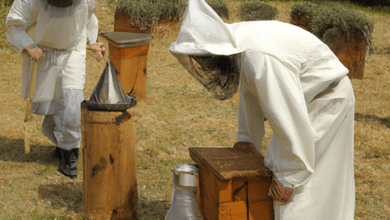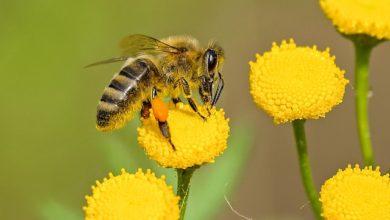Varroa Mite Treatment
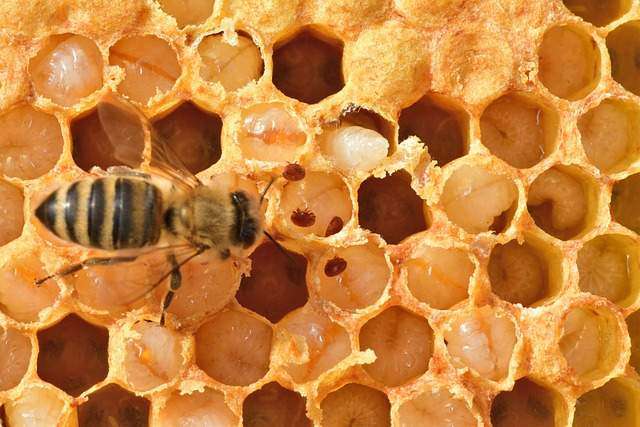
What is a Varroa Mite?
Varroa destructor is also known as Varroa mite and it is parasitic. It feeds on honey bees and attacks them. It causes a disease called varroosis.
An adult male mite is white while the female is red-brown. These mites are flat and have a button shape. Their length ranges between 1 to 1.8mm and the width ranges between 1.5 to 2milimeter. Moreover, they have eight legs and lack eyes. One mite has an approximate weight of 0.453miligrams.
The mite reproduces in the colony of a honey bee. It will attach itself to the honeybee’s body and weaken the bee by sucking its body fats.
The mite species cause five debilitating viruses in bees, such as RNA viruses. For example (DWS) is a deformed wing virus. Moreover, a great mite infestation in the bee colony causes death in late autumn and early spring.
Varroa mite has the greatest economic impact on the beekeeping industry. The mite is one factor contributing to high numbers of bee losses worldwide.
Varroa Mite Reproduction
These mites reproduce through a ten-day cycle. The female mite attacks the bee brood cell. After the cell has been capped, the mite will lay eggs. When the eggs hatch, there will be one male and several females.
At the same time, a young bee will develop, then leave the host cell. The mites also spread to larvae and other bees when the young bee develops after pupation
Moreover, the mites like infesting the drone cells because they will reproduce in only three days compared to cells of a worker bee. This leads to genetic defects, for example, fungi or viruses in the bee or useless wings.
Feeding
The adult mites suck fat on adult bees and their larvae for survival. The fat body is vital for bee’s body functions such as immunity, energy regulation, pesticide detoxification, and hormone.
Therefore, without the fat, the bee is in a weakened state. Furthermore, adult mites feed and live under the abdominal plates of bees, especially underneath the metasoma region on the left.
Varroa Mite Infection
After feeding, open wounds left by the mites become infected with virus infections and diseases. The mite leads to five debilitating bee viruses, which are known, but there is a possibility of up to eighteen unknown viruses.
Moreover, the Russian honey bee (Varroa sensitive hygiene) colonies have resistance to this parasite. The Apis mellifera bees found in Europe are defenseless to these parasites.
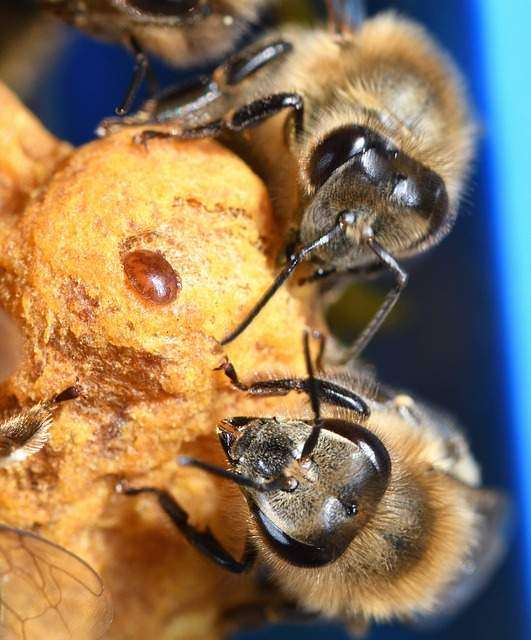
Hive Mortality
The population dynamics in a beehive is exponential growth when the brood is available. However, the population will decline exponentially when brood is unavailable and the mites like invading the colonies during summer, leading to a high mite population during autumn.
A high population of mites leads to elimination of drone rearing and the depletion of worker larvae causing a population crash. The crash leads to hive death.
Varroa Mite Monitoring
There are different methods of monitoring mites in colonies. The various methods you can use include:
a) Powdered sugar roll method
You will collect about 300 bees using a measuring cup. After collecting the bees, place them in a jar, screen the lid with a wire mesh, and add two tablespoons of sugar. Then gently swirl the jug for a few minutes and turn it upside down while shaking the mites as they fall over a tray.
You will count the mites and divide the number by three to get the number of mites per hundred bees. Using sugar helps to prevent the killing of sampled bees; however, the shaking causes the death of some bees.
b) Alcohol Wash Method
You will collect three hundred bees using a similar cup as a sampler. The alcohol concentration usually is seventy percent or more. Then you will use a jar with a lid where you will shake it vigorously for a few minutes and then pour it into a wire mesh over a tray. After that, you will count the number of mites and divide them by three. However, this method will kill the sampled bees.
c) Sticky Board Method
The sticky board method has a thick jelly (petroleum) coating on the brood section under the screened bottom board.
You will check the board after three days and count the number of mites stacked on the board. Then you will divide the number by three, which will be the twenty-four-hour mite drop. The advantage of this method is that it does not kill bees; however, the results will take longer.
Chemical Treatment of Varroa Mite
You can use acaricides to treat Varroa mites. When using this chemical, you need to apply it carefully to avoid contamination of honey. Moreover, the use of miticides slows the mites from developing resistance. The chemicals can be of two types, either naturally occurring or synthetic chemicals

Naturally occurring chemicals include:
- Essential oils such as thyme oil, mint, and lemon
- Sugar esters in spray application
- Formic acid
- Powdered sugar
- Natural hops compounds
- Mineral oil as vapor (food grade)
- Oxalic acid applied as vapor
Synthetic chemicals include:
- StopVarro containing oxalic acid
- Amitraz, as strips
- Organophosphate insecticide as strips (Coumaphas or Check-mite)
- Pyrethroid insecticide as strips(fluvalinate)
- Manley’s Thymol Crystal
The effective method of guarding your hive against V.destructor is breeding bees that have resistance against these mites.
Physical, Mechanical, and Behavioral Methods
Varroa mites are also controlled through nonchemical methods. These methods are intended to reduce the population of mites to a manageable number, not eliminate them. These methods include:
a) Perforated Bottom Board
Beekeepers use it to protect their hives. When a mite falls off a bee, it must climb up again to parasitize other bees in the hive. Therefore, if the beehive contains a screened floor with a mesh, the mites will fall off and will not return to the hive.
The screened bottom floor helps to increase air circulation, hence reducing condensation in the hive. Screened bottom boards containing glue traps or (sticky boards) separate falling mites through the screen and sticky boards ensure mites cannot crawl back up.
b) Heating
Beekeepers practiced the heating method in Eastern Europe; however, it later became a worldwide method. In this method, you will heat the hive frame to 40oc for several hours, which makes the mites fall off from the bees.
Moreover, combining this method with a perforated bottom board will help mitigate the colony survival in the hive.
In Germany, professional beekeepers manufacture anti-varroa heaters. Also, it has a thermosolar hive patent manufactured in the Czech Republic.
c) Drone Brood Excision
It is a variation applied on the top of bar hives. Honey bees place the suitable combs for drones on the outer margins and the bottom of the comb. Cut this comb off, especially during the purple eye stage, and throw it away to reduce mite load. It will also allow for counting and inspection of brood for mites.
d) Freezing Drone Brood
This method takes advantage of the mite’s preference for a long-living drone brood. As a beekeeper, you will put a sizeable frame to ensure the queen lays drone brood primarily.
After the brood is capped, you will remove the frame and keep it in a freezer. By doing this, the mites feeding on the bees will die. It will also kill the drone brood; however, many hives produce extra drone bees, so there will be no loss.
After you are done freezing, you can return the frame to the hive. The nurse bees are responsible for cleaning out the dead mites (dead brood).
e) Comb trapping
It is also known as the swarming method; it involves disturbing the bees’ brood cycle. It also involves removing capped broods from the hives, where the mites breed.
The queen is usually found in a comb cage. After every nine days, the queen moves to a new comb, and the previous comb containing the brood is reared and eventually removed.
After this, you keep repeating the cycle. The method is complex; however, it removes eighty percent of mites found in the hive.
f) Limited Drone Brood Cell
In this method, the brood space for mites to inhabit is limited. It also enhances the differential size between the drone brood and the worker to make comb traps efficient in trapping mites. Moreover, small cell foundations contain advocates.
What is the best way to treat Varroa mites currently available?
The best way to treat mites is using oxalic and formic acids for entire seasons. However, you must remember that treatments have limitations such as brood, temperature, honey flow, and population. Therefore, make sure your treatments are varied to tackle resistance from mites.
What do Varroa mites do to bees?
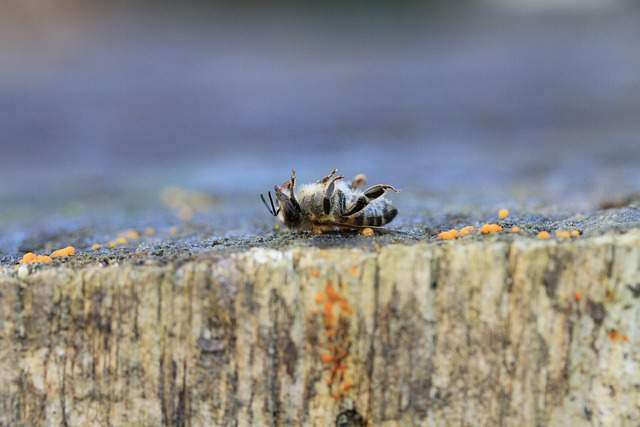
These mites are destructive to honey bees. The adult female mites lay their eggs in various brood cells of hives. The mites eat the bees’ pupae and larvae, which leads to the deformation of the bodies and wings of the bees when they mature. Moreover, these mites eat adult bees.
Where does Varroa destructor come from?
The origin of these mites is Asia. The parasite was found on the Apis cerana (the Asian honeybee). Not long ago, the Varroa mites were grouped as Varroa jacobsoni, which was a species first described in 1904 in Java. However, it was later discovered it was all over mainland Asia.
What is the appearance of mites in a beehive?
These mites appear like ticks on bees. The mites look like red-brown (coppery brown) discs that are 1.5 millimeters wide. These mites are highly mobile. The mites pierce through the bee’s body fat to feed.
How long should you wait to check for mites?
It would be best if you plan to check for mites once each month, especially during bee season. During late summer, you should plan to check your hive frequently because, during this time, there is a high risk of mite infestation.
Test each hive to get specific data if you have less than eight hives. If you want to determine the risk of the mites, examine at least eight hives.
What month should you treat mites?
Most beekeepers prefer to treat their hive against mites during August and later in winter when the capped brood is available. It would be best if you also carried out a second treatment in winter for strong colonies that stole other colonies during fall. Robbers prefer to attack a weaker colony.
When should I start treating my hive for Varroa mite?
Most beekeepers prefer to treat their hives against mites during August and later in winter when the capped brood is available. It would be best if you also did a second treatment in winter for strong colonies.
How much oxalic acid should you use on your bees?
You can use the oxalic acid during winter when colonies are broodless and later in summer. The treatment in summer is done after caging the queens for twenty-one days.
Does oxalic acid destroy honey?
Oxalic acid destroys open brood. When the brood is damaged during honey flow, it weakens the colony during summer. There are honey treatments that are used when the honey super is present. They usually work through the various cappings.
Oxalic Acid Disadvantages
Oxalic acid is colorless and poisonous. It is a caustic chemical
Symptoms of poisoning by oxalic acid include:
- Seizures
- Mouth pain
- Drooling
- Shock (blood pressure drops)
- Vomiting
- Tremors
- Throat pain plus swelling causing difficulty breathing
- Abdominal pain
- Blisters and burns
Symptoms of having oxalic acid spill in the eyes or your skin include:
- Severe pain
- Vision loss
- Burning
Safety Precaution
It would be best to be cautious when treating your hives with oxalic acid. Always put on your gloves when dealing with oxalic acid.
You need to wear protective clothing to protect your skin from contact with acid. When vaporizing the oxalic acid, you must wear goggles and a respirator.
What can you use to kill Varroa mites naturally?
You can use formic acid. It is a natural compound of honey. It is widely used because high acid concentrations penetrate the cappings to kill the reproducing mites.

Is powdered sugar effective in treating mites?
Powdered sugar is combined with a screen bottom board or sticky board. The sugar makes the mites fall off but does not kill them. Therefore, if there is no sticky board where the mites fall, they will eventually crawl back.
How many times can you use powdered sugar to treat bees?
You should pour one cup of sugar on the frames of the hives for at least three consecutive weeks each week.
How do you prepare mites’ sugar shakes?
You will shake the iced sugar from the holes into the bucket through the lid. Make sure your bucket contains half-filled water. The sugar dissolves and mites float on the water. You need to make sure you are in a protected area away from the wind.
Summary
There are various methods for controlling the mite population in bee colonies. Each method has merits and demerits.
However, it is essential to understand each method before making the final decision. Beekeepers should prefer using mechanical and cultural methods for controlling mites before using chemicals.
Rotation of treatment and mite monitoring is vital for effectively reducing and managing these parasites with chemical resistance.
Understanding and considering various methods before deciding which method to use will increase the chance of your honey bees thriving and success in your beehives.

